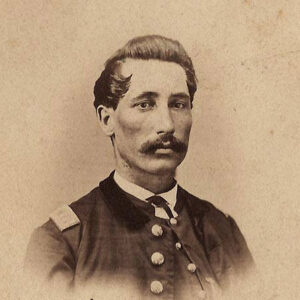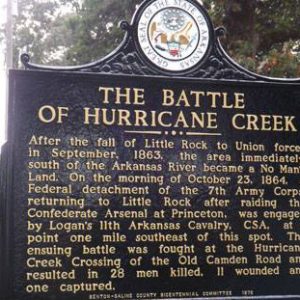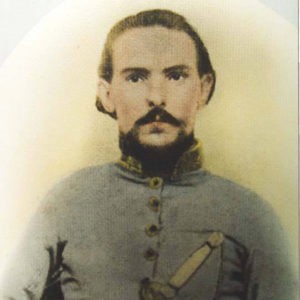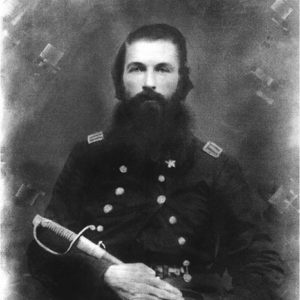calsfoundation@cals.org
Skirmish at Hurricane Creek
aka: Skirmish at Hunter's Crossing
| Location: | Saline County |
| Campaign: | Occupation of Arkansas 1864 |
| Dates: | October 19–23, 1864 |
| Principal Commanders: | Colonel John L. Logan (CS); Major George S. Avery (US) |
| Forces Engaged: | Eleventh Arkansas Cavalry/Poe’s Arkansas Cavalry and Second Texas Cavalry (CS); Detachments of the First Missouri Cavalry, Third Missouri Cavalry, Ninth Kansas Cavalry, First Iowa Cavalry, Fourth Arkansas Cavalry, and Third United States Cavalry (US) |
| Estimated Casualties: | 27 killed, 1 captured (CS); 2 killed, 11 wounded (US) |
| Result: | Union victory |
The Skirmish at Hurricane Creek was a Civil War battle fought on October 23, 1864, at Hunter’s Crossing, two miles south of present-day Bryant in Saline County. Confederate forces ambushed a Union cavalry force on its return to Little Rock (Pulaski County) from a raid on Princeton (Dallas County).
On October 19, Major George Avery’s Union cavalry command left Little Rock and proceeded to Princeton in order to capture and destroy weapons reportedly stored there. On October 21, they were met near Tulip (Dallas County) by the advance pickets of Colonel John L. Logan’s cavalry, resulting in constant skirmishing until reaching Princeton. Here, the Confederates were pushed south of town approximately two miles. The Union forces returned to Princeton, where they found a small number of weapons, which they destroyed, and then began the return trip toward Little Rock. They camped near Jenkins’ Ferry that evening, and eight miles from Hunter’s Crossing on Hurricane Creek the night of October 22.
Colonel Logan pushed his Confederate command rapidly in pursuit and managed to maneuver his troopers in front of the Union forces just north of Hunter’s Crossing during the night of October 22. On the morning of October 23, as Union forces crossed and cleared Hurricane Creek, Logan’s troopers opened fire, resulting in a battle involving all forces. After forty-five minutes, the Confederates retired from the battlefield, and Major Avery, fearing a reinforced Confederate assault, gathered his casualties and moved rapidly toward Little Rock.
After the battle, local citizens gathered the dead and buried them in the local Methodist church cemetery, one mile away. One woman stated, “The wounded, dying, and dead were all lying in heaps here and there. The moans of the wounded and the groans of the dying remained many long years in my memory.” Major Avery reported his losses as two men killed and eleven wounded but stated there were twenty-seven dead Confederates left on the battlefield. Major Avery’s account creates a mystery as to how an ambushing force could lose so many dead. Afterward, Colonel Logan accused the Union forces of “summarily executing his wounded and captured.” This may attribute to the higher number of Confederate dead as reported by Union officers. Major General Frederick Steele was made aware of the event, but no further information exists documenting a possible massacre of the wounded Confederates.
Six tombstones for unknown Confederates in the Bryant Cemetery (the same Methodist church cemetery) mark the general location of burials of known casualties, but a large area marked with at least twenty-five similar field stones is adjacent to the markers. Only one Confederate death is identified, that of William Anderson Penn of Company C, Second Texas Cavalry. An Arkansas Bicentennial Historical Marker, refurbished by the Arkansas Civil War Sesquicentennial Commission, is located at the Bryant Cemetery and commemorates the skirmish.
For additional information:
Demuth, David O. “Federal Military Activity in Arkansas in the Fall of 1864 and the Skirmish at Hurricane Creek.” Arkansas Historical Quarterly 38 (Summer 1979): 131–145.
The War of the Rebellion: A Compilation of the Official Records of the Union and Confederate Armies. Series 1, Vol. 41, Parts 1, 4. Washington DC: Government Printing Office, 1889.
Anthony Rushing
Benton, Arkansas
 Civil War Timeline
Civil War Timeline Military
Military ACWSC Logo
ACWSC Logo  George S. Avery
George S. Avery  Hurricane Creek Marker
Hurricane Creek Marker  John L. Logan
John L. Logan  James T. Poe
James T. Poe 




Comments
No comments on this entry yet.